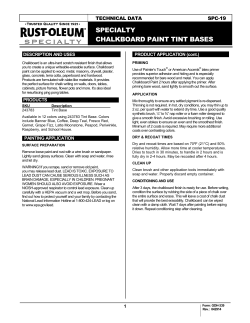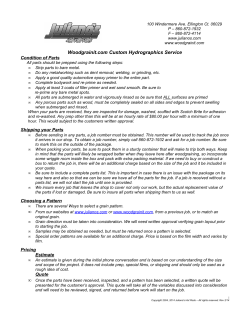
Fiberglass No Sand Primer
Fiberglass No Sand Primer Interlux® Fiberglass No Sand Primer YPA200 is designed to eliminate the need to sand prior to applying antifouling paint to new or unpainted boats. Fiberglass No Sand Primer YPA200 can be used on bare gelcoat (polyester or vinylester) and epoxy primed fiberglass. It is compatible with most Interlux Antifoulings. Apply Fiberglass No Sand Primer by brush and roller only, DO NOT SPRAY. PRODUCT DATA Product Code & Color: YPA200 Gray Coverage: 535 sq. ft. per gallon per coat. 13.1m per liter. Volume Solids: 25% Surfaces: Fiberglass Gelcoat, Polyester, Vinylester and Epoxy primed surfaces. Application: Brush or Roller only. Do not Spray. Application Temperature: 50°F (10°C) to 95°F (35°C) Coats Required: One. V.O.C.: 5.76 lbs/gal (690 grams/liter) as supplied. Case Pack: 6 quarts per case, 2 gallons per case. PRODUCT COMPATIBILITY Fiberglass No Sand Primer YPA200 is compatible with most Interlux Antifoulings. Do not use Fiberglass No Sand Primer with Micron 66, VC17m, VC17m Extra, Fiberglass Bottomkote Aqua, Micron Optima, VC Offshore or Baltoplate. Do not use with any water-based or vinyl based antifouling paints. ASSOCIATED PRODUCTS PRODUCT CODE DESCRIPTION 202 Fiberglass Solvent Wash – To clean bare fiberglass prior to application. YMA601 Fiberglass Surface Prep – Water based cleaner for bare fiberglass. 2316N Reducing Solvent– For clean up. Interlux antifoulings Check compatibility RECOMMENDED APPLICATION SYSTEMS General Directions PREPARATION Prior to the application of Fiberglass No Sand Primer all contamination such as mold release wax, oil, grease or blush from epoxy or vinylester resins must be removed. If the contamination is not removed the antifouling paint will delaminate. BARE FIBERGLASS (POLYESTER or VINYLESTER) or EPOXY: Begin by scrubbing well using Fiberglass Surface Prep YMA601 and a plastic scrub pad. If Fiberglass Surface Prep YMA601 is not available use an abrasive powder cleaner and a plastic scrub pad. Flush well with fresh water. Wipe a small area with a clean rag that has been wetted with INTERLUX® Fiberglass Solvent Wash 202. Before the Fiberglass Solvent Wash dries wipe with a clean dry rag. Change rags frequently. Continue this process until the entire surface has been cleaned. To be certain that wax and other contamination has been removed, run water over the surface. If the water beads up or separates, wipe the surface again with INTERLUX® Fiberglass Solvent Wash 202. When the water sheets off, all contamination has been removed. Sanding does not remove contamination. APPLICATION • Clean the surface as per system above. Stir contents well. Do not shake. • Apply one, thin, continuous coat of Fiberglass No Sand Primer using a 1/4”nap, solvent resistant roller or natural bristle brush, Apply in one direction only without overcoating. • Overcoating times will vary due to wide variations in temperature and humidity. The best method to determine when the Fiberglass No Sand Primer is Ready-to-Overcoat is to check the paint film using the “Thumb Print” test. If the primer feels tacky and you can leave a thumbprint in the paint film without getting any paint on your thumb the Fiberglass No-Sand Primer is ready for overcoating. Test the paint film in the area where you started applying the primer 30 minutes after starting the application. Continue testing every 15 minutes using the “Thumb Print” test until reaching the ready-to-overcoat stage. Immediately, begin to apply the Interlux antifouling paint once the primer has reached the Ready-ToOvercoat stage. • Do not apply if the Relative Humidity exceeds 85% or if the Temperature exceeds 95°F (35°C). Check primed surfaces using the “Thumb-Print” test before overcoating with antifouling. • If you cannot leave a thumbprint in Fiberglass No-Sand Primer YPA200 or it is “tack free” it is too late to overcoat and the primer must be removed. • Follow application instructions on the antifouling label for overcoating times of subsequent coats. APPLICATION NOTES • Apply one thin coat only. Fiberglass No Sand Primer may not hide the gelcoat completely when applied properly. • Wear protective clothing and clean up paint spatters immediately. Paint left to dry on skin will be extremely difficult to remove and may take several weeks to wear off. Use waterless hand cleaner before the Fiberglass No Sand Primer dries to remove from skin. • Overcoat Fiberglass No Sand Primer with single part paints only. • Remember that Fiberglass No Sand Primer is moisture sensitive. Do not leave containers open during application. • Once project is complete discard all paint remaining in trays or containers. • Do not apply if the Relative Humidity exceeds 85% or if the Temperature exceeds 95°F (35°C) International Paint Inc., 2270 Morris Avenue, Union, NJ 07083 tel: (908) 964-2391 toll-free: 1-800-468-7589 fax: (908) 686-8545 Issue Date 2-2003
© Copyright 2025





















